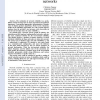Free Online Productivity Tools
i2Speak
i2Symbol
i2OCR
iTex2Img
iWeb2Print
iWeb2Shot
i2Type
iPdf2Split
iPdf2Merge
i2Bopomofo
i2Arabic
i2Style
i2Image
i2PDF
iLatex2Rtf
Sci2ools
CORR
2008
Springer
2008
Springer
Exact two-terminal reliability of some directed networks
Abstract-- The calculation of network reliability in a probabilistic context has long been an issue of practical and academic importance. Conventional approaches (determination of bounds, sums of disjoint products algorithms, Monte Carlo evaluations, studies of the reliability polynomials, etc.) only provide approximations when the network's size increases, even when nodes do not fail and all edges have the same reliability p. We consider here a directed, generic graph of arbitrary size mimicking real-life long-haul communication networks, and give the exact, analytical solution for the two-terminal reliability. This solution involves a product of transfer matrices, in which individual reliabilities of edges and nodes are taken into account. The special case of identical edge and node reliabilities (p and , respectively) is addressed. We consider a case study based on a commonly-used configuration, and assess the influence of the edges being directed (or not) on various measures o...
| Added | 09 Dec 2010 |
| Updated | 09 Dec 2010 |
| Type | Journal |
| Year | 2008 |
| Where | CORR |
| Authors | Christian Tanguy |
Comments (0)

